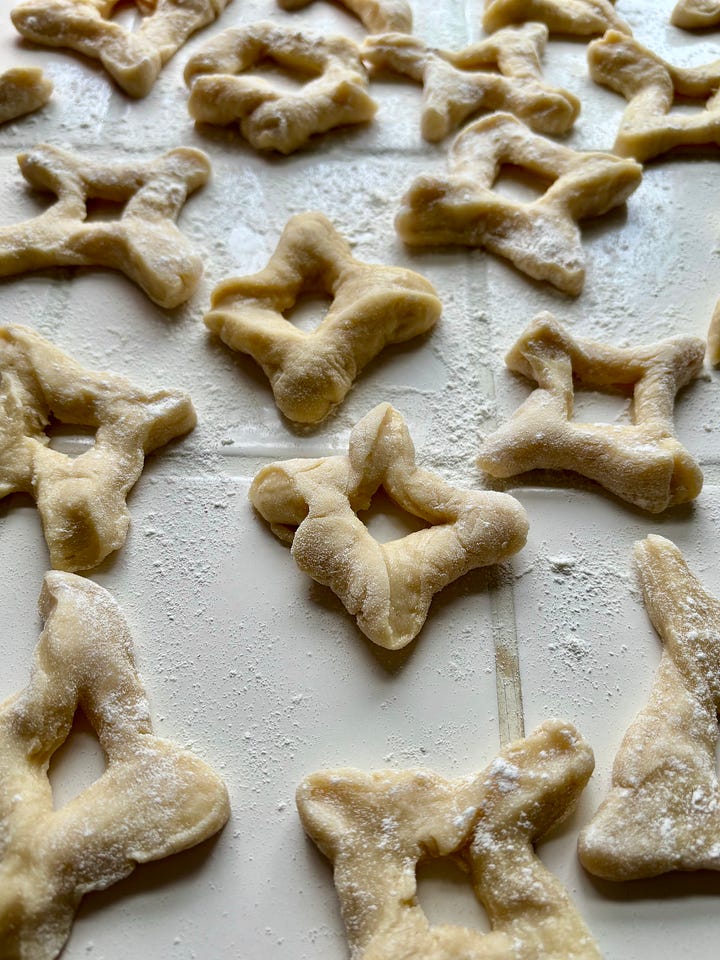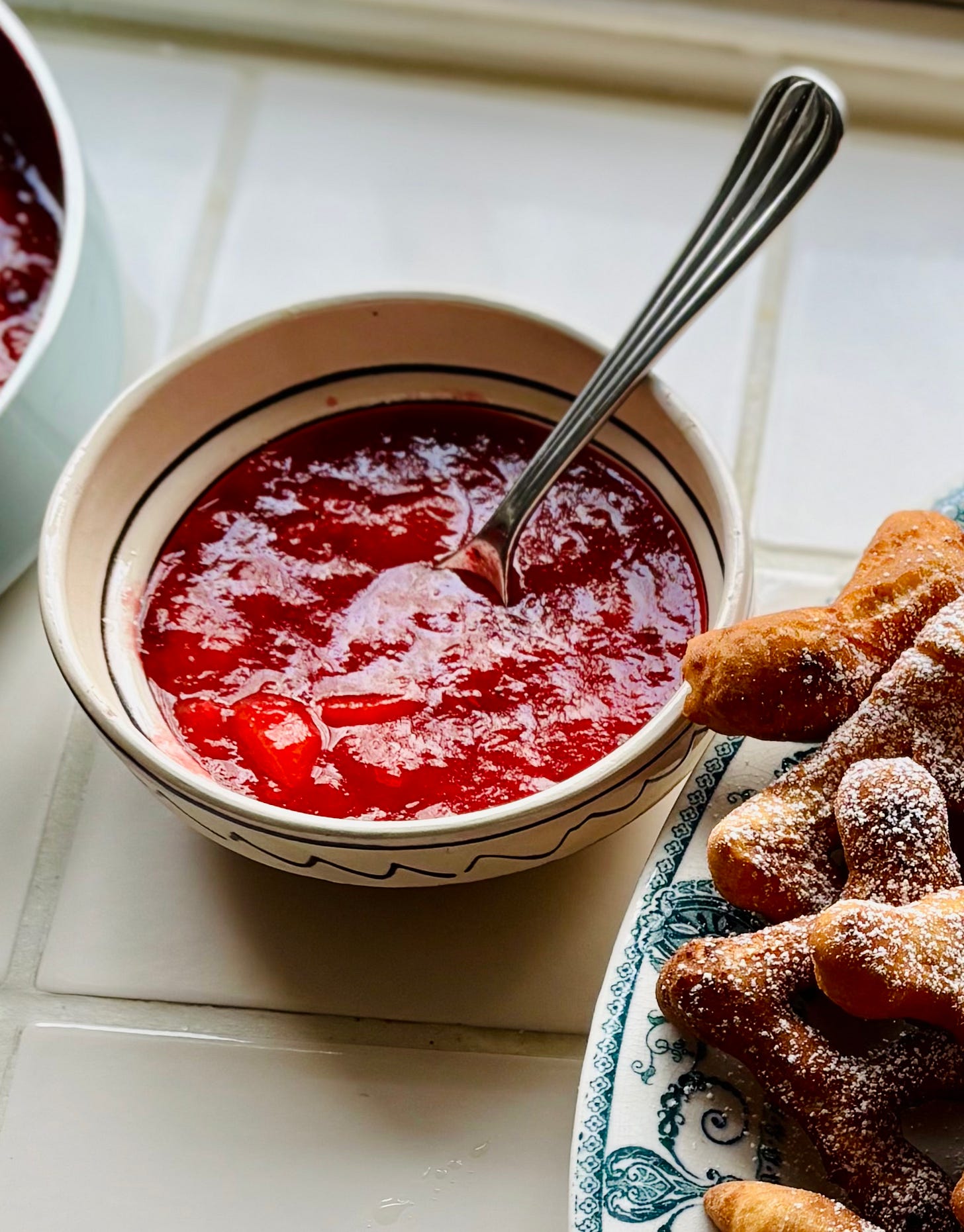As I write this, I am aware of the many doughnuts and fried pastries that have inundated social media lately. And rightly so: it’s Carnival time, the feast and indulgences we succumb to before the great, lean Easter Lent begins. Various culinary traditions exist in Christian religions, especially in Catholicism, where doughnuts are a big deal.
In my books, I always talk about the ethnic communities that belong to the area or regions I research. However, not everything can be included, and social media and Substack are places where I can add to the story. Otherwise, my books would be filled with footnotes, disclaimers and…digressions.
Bulgarians in Romania
This story comes from the Bulgarian communities featured in my book ‘Danube’, particularly in the chapter focusing on the vegetable growers of southern Romania. These groups crossed the Danube River into Romania a couple of centuries ago, fleeing the Ottoman Empire to find shelter and a new home in this new country.
Like any new beginnings, their arrival in Romania is surrounded by myth. As people, we are united by the same Orthodox religion (Greek rite), follow the same religious celebrations and, therefore, have similar culinary traditions. You can read all about them in ‘Danube’ (here), while below, I’ll give you a new story, that’s not in my book.
Paulician Bulgarians
Since the fall of the Roman Empire, Christianity has been hotly discussed, adapted, reinterpreted, ‘conclaved’, and divided. In the first century AD, a certain group, known as ‘the followers of Paul,’ was uprooted from its ancestral land in today’s modern Turkey and spread throughout the Balkans, with many settling in Plovdiv, Bulgaria.
Knowing Bulgarians’ devotion to their Orthodox religion and pride in having played a decisive role in Eastern Europe’s choice of faith, I doubt that the new group was welcomed with open arms. The Bulgarians already had their own heretic group, the Bogumili, named after their leader. Even so, the Pauliceni spread and became one of the largest heretic groups in the Balkans, with its hub in Plovdiv, Bulgaria.
Bugger, a digression
The multitude of heresies in the Balkans led the medieval Western world to perceive Bulgaria as the source of these beliefs, coining the Old French term 'bougres' (derived from Bulgarus) to describe troublesome and even sodomitic groups. The evolution to 'bugger' only required a short jump across the channel to England.
From buggers to Catholics
In the 17th century, Catholic missionaries from Croatia and the Adriatic, made it their aim to convert various heresies in Europe. The Paulicians, who were then under Ottoman control, hoped that Western help would liberate Bulgaria from Muslim rule. So they converted. When the help didn’t come, they crossed the Danube into Romania, seeking to join other Bulgarians there. Old religious tensions got the better of both groups, after all the Paulicians were Catholics, so they had to go West and find new land under the more favourable governance of Catholic Germans, Austrians and Hungarians in Transylvania.
It’s here where I found them while researching for my book ‘Danube’. In the Banat region, I discovered communities situated well north of the Danube, working to re-discover their identity and culture. ‘We are not Paulicians, we are Catholics,’ one person states, adding, ‘we stopped being Paulicians long ago.’ Their dialect, a unique blend of Bulgarian and Croatian (!), has been remarkably preserved through the ages. Their culinary traditions, however, are less intact, showing Austro-Hungarian influences, as the name Fărșang suggests, with many customs significantly shaped by Romanian culture, particularly during the Communist era. Today, people often travel to Bulgaria for folk traditions and costumes to bring back to Romania, which I believe is wrong, but there you have it. It’s easier.
Fărșang Carnival
A significant celebration that connects this story to Carnival is Fărșang, a name of German origin (from Fasching). In fact, the entire period from January through to the end of Carnival in March is referred to as Gustenin, derived from "Gast"( German again) meaning guest. A lot of visits among relatives and friends mark this season and a lot of food and merriment. What do they prepare more often during this festive season? Doughnuts.
In Dudeștii Vechi village in Banat, Romania, the doughnuts take on a unique shape and are called vrejcule.
Vrejcule Doughnuts with Aniseed Plum Jam - Recipe
Just to be clear from the beginning, the plum jam is not traditional, but I love it, and I think the aniseed, being a spice loved in German baking, is a gentle nod to this Bulgarian community's past.
Ingredients
Serve 4-6 (or more, they are for a party!)
2 whole medium size eggs, beaten
125ml full fat milk
100g caster sugar
450g self-raising flour
1 pinch of salt
For the plum jam:
4-5 plums, sliced
1 medium size lemon - juice only
2 tbsp caster sugar
2 tsp aniseed seeds


Method:
Make the dough by first mixing the wet ingredients, then incorporating the dry ingredients. Knead the mixture until it is smooth, then divide it into four equal portions. Roll each piece into a rope approximately 25-30 cm long. Cut sections of about 6 cm and make a cut at both ends to slightly overlap, then open them out like a star. I’ll show you how in this video (there will be a full video of this recipe on my Instagram here)
Shallow or deep fry for a couple of minutes at 170C oil temperature. Transfer onto a sieve while another batch is frying, then onto a plate. Sprinkle with icing sugar.
Meanwhile, make the jam: slice the plums, add the lemon juice, sugar and aniseeds and cook for 15 minutes until soft. Add some water if necessary; the plums need to have enough liquid to stew first, then you can reduce it to your desired consistency (not too drippy, I hope). It needs to cling to the doughnut when you dip it in.
Gogoși, the generic term for doughnuts in Romanian
In Romania, doughnuts are not necessarily related to the Carnival. We eat them all the time :-) including a famous recipe for papanași: curd cheese doughnuts served with sour cream and cherry jam (recipe in my book, Carpathia, here) In Saxon Transylvania, the curd cheese is a filling, like in my book ‘Tava’ (here) . Or twisted, a brioche type of doughnut, twisted before frying. Or, indeed, minciunele, fried pastry like in my book ‘Tava’, where I glazed them with butter and vanilla.




New Interview with Recipes Here
I had the pleasure of chatting with author Domenica Marchetti about the recipes in ‘Danube’. You can now read the interview here. Domenica worked with illustrator Daniela Bracco to create the beautiful images you can see in the substack post. I hope you like the interview and recipes.










Great info on Bulgarian migrations, fascinating stories, gorgeous recipe (I've made the jam with no sugar and dried plums - prunes - because I had too many over from last year - addition of aniseed excellent suggestion) - many thanks, Irina!
Well i’m so pleased and happy to read about the Pavlicani and their catholic integration as i belong to that very catholic- pavlicani community in Plovdiv. There are so many stories to tell, transmitted down the generations in my family, keeping their proud independent identity and a very special approach.